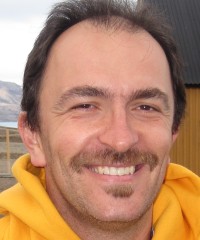 |
|
Ph.D. in Plant Pathology and Molecular Evolutionary Genetics, Pennsylvania State University, University Park, PA, USA (2001-2004)
Ph.D. in Mycology, Corvinus University of Budapest, Budapest, Hungary (1998-2005)
Arctic fieldwork experience:
Ny-Alesund, Svalbard, Norway (2010)
Yamal Peninsula, Siberia, Russia (2008)
Toolik Lake, Alaska, USA (2007)
Barrow, Alaska, USA (2006)
Toolik Lake, Alaska, USA (2006)
Research interests
My current research focuses on the biodiversity and phylogeography of arctic fungi. The arctic tundra is on the brink of significant changes and there are serious concerns among researchers and the public alike related to the future of arctic biodiversity. Despite the critical roles fungi play in the functioning of arctic ecosystems, especially as symbionts of plants and recyclers of organic matter, their biodiversity and ecology are poorly known in high-latitude regions.
I combine large-scale DNA sequence data of soil fungal communities with in-depth, collection-based taxonomic work (including multi-locus phylogenetics and morphological data analyses) to assess the biodiversity of fungal communities in the Arctic, utilizing the complementary strengths of systematics and metagenomics. In addition, I apply phylogenetic and coalescent methods to study speciation and phylogeography in arctic and boreal fungi with potential applications of pinpointing hot spots of genetic biodiversity for nature conservation and improving inferences concerning glacial refugia.
Publications
Geml J. Coalescent analyses reveal contrasting patterns of inter-continental gene flow in arctic-alpine and boreal-temperate fungi. In: Biogeography of microscopic organisms - Is everything everywhere? (Ed. Fontaneto D) Springer (in press).
Geml J, Laursen GA, Timling I, McFarland JM, Booth MG, Lennon N, Nusbaum HC, Taylor DL. 2010. Phylogenetic and ecological analyses of soil and sporocarp DNA sequences reveal high diversity and strong habitat partitioning in the boreal ectomycorrhizal genus Russula Pers. (Russulales; Basidiomycota). New Phytologist doi:10.1111/j.1469-8137.2010.03283.x. Journal Impact factor: 5.178
Geml J, Kauff F, Brochmann C, Taylor DL. 2010. Surviving climate changes: High genetic diversity and transoceanic gene flow in two arctic-alpine lichens, Flavocetraria cucullata and F. nivalis (Parmeliaceae, Ascomycota) Journal of Biogeography doi:10.1111/j.1365-2699.2010.02287.x. Journal Impact factor: 4.566
Geml J, Kauff F, Laursen GA, Taylor DL. 2010. Genetic studies point to Beringia as a biodiversity hotspot for high-latitude fungi. In: Alaska Park Science: Natural and Cultural Heritage of Greater Beringia (Ed. Winfree RA), National Park Service, Alaska Regional Office, p. 37-41.
Geml J, Tulloss RE, Laursen GA, Sazanova NA, Taylor DL. 2009. Phylogeographic analyses of a boreal-temperate ectomycorrhizal basidiomycete, Amanita muscaria, suggest forest refugia in Alaska during the Last Glacial Maximum. In: Surviving on Changing Climate - Phylogeography and Conservation of Postglacial Relicts. (Ed. Habel J) Springer p. 173-189.
Geml J, Laursen GA, Timling I, McFarland JM, Booth MG, Lennon N, Nusbaum HC, Taylor DL. 2009. Molecular phylogenetic biodiversity assessment of arctic and boreal Lactarius Pers. (Russulales; Basidiomycota) in Alaska, based on soil and sporocarp DNA. Molecular Ecology 18:2213-2227. Journal Impact factor: 5.325
Geml J, Tulloss RE, Laursen GA, Sazanova NA, Taylor DL. 2008. Evidence for strong inter- and intracontinental phylogeographic structure in Amanita muscaria, a wind-dispersed ectomycorrhizal basidiomycete. Molecular Phylogenetics and Evolution 48:694-701. Journal Impact factor: 3.994
Geml J, Laursen GA, Taylor DL. 2008. Molecular phylogenetic diversity assessment of arctic and boreal Agaricus taxa. Mycologia 100:577-589. Journal Impact factor: 2.359
Geml J, Laursen GA, Nusbaum HC, Taylor DL. 2007. Two new species of Agaricus from the Subantartic. Mycotaxon 100:193-208. Journal Impact factor: 0.535
Hosaka K, Bates S, Beever R, Castellano M, Colgan W, Dominguez L, Nouhra E, Geml J, Giachini A, Kenney S, Simpson N, Trappe J. 2006. Molecular phylogenetics of the gomphoid-phalloid fungi with an establishment of the new subclass Phallomycetidae and two new orders. Mycologia 98:949-959. Journal Impact factor: 2.359
Geml J, Laursen GA, O'Neill K, Nusbaum HC, Taylor DL. 2006. Beringian origins and cryptic speciation events in the Fly Agaric (Amanita muscaria). Molecular Ecology 15:225-293. Journal Impact factor: 5.325
Tan Q, Romaine CP, Schlagnhaufer C, Chen MJ, Guo Q, Geml J, Garzon C. 2006. DNA fingerprinting of six Pleurotus nebrodensis strains cultivated commercially in China. Acta Edulis Fungi 13:20-23.
Geml J, Davis DD, Geiser DM. 2005. Systematics of the genus Sphaerobolus based on molecular and morphological data, with the description of Sphaerobolus ingoldii sp. nov. Mycologia 97:680-694. Journal Impact factor: 2.359
Geml J, Davis DD, Geiser DM. 2005. Influence of selected fungicides on in vitro growth of artillery fungi (Sphaerobolus spp.). Journal of Environmental Horticulture 23:63-66.
Geml J, Davis DD, Geiser DM. 2005. Phylogenetic analyses reveal deeply divergent species lineages in the genus Sphaerobolus (Phallales: Basidiomycota). Molecular Phylogenetics and Evolution 35:313-322. Journal Impact factor: 3.994
Geml J, Geiser DM, Royse DJ. 2004. Molecular evolution of Agaricus species based on ITS and LSU rDNA sequences. Mycological Progress 3:157-176. Journal Impact factor: 1.791
Geml J. 2004. Evolution in action: Molecular evidence for recent emergence of secotioid genera Endoptychum, Gyrophragmium and Longula from Agaricus ancestors. Acta Microbiologica et Immunologica Hungarica 51:97-108.
[BACK]